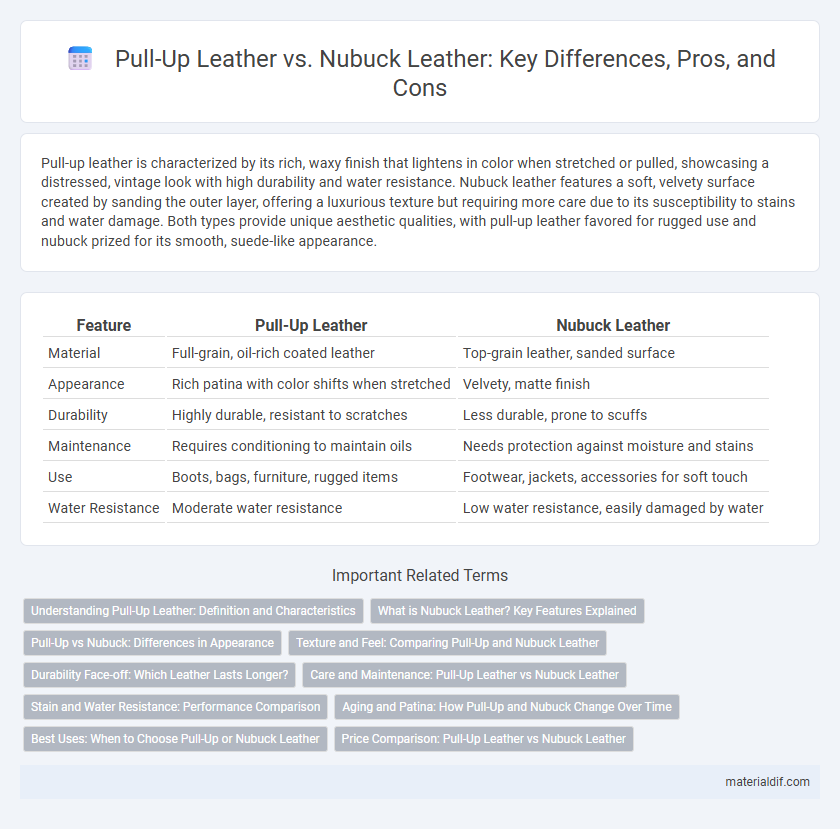Pull-up leather is characterized by its rich, waxy finish that lightens in color when stretched or pulled, showcasing a distressed, vintage look with high durability and water resistance. Nubuck leather features a soft, velvety surface created by sanding the outer layer, offering a luxurious texture but requiring more care due to its susceptibility to stains and water damage. Both types provide unique aesthetic qualities, with pull-up leather favored for rugged use and nubuck prized for its smooth, suede-like appearance.
Table of Comparison
| Feature | Pull-Up Leather | Nubuck Leather |
|---|---|---|
| Material | Full-grain, oil-rich coated leather | Top-grain leather, sanded surface |
| Appearance | Rich patina with color shifts when stretched | Velvety, matte finish |
| Durability | Highly durable, resistant to scratches | Less durable, prone to scuffs |
| Maintenance | Requires conditioning to maintain oils | Needs protection against moisture and stains |
| Use | Boots, bags, furniture, rugged items | Footwear, jackets, accessories for soft touch |
| Water Resistance | Moderate water resistance | Low water resistance, easily damaged by water |
Understanding Pull-Up Leather: Definition and Characteristics
Pull-up leather is a type of full-grain leather known for its unique characteristic of changing color when stretched or pulled, creating a distinctive, distressed look. It is treated with special oils and waxes that enhance its durability and water resistance while maintaining a soft, supple texture. This treatment allows pull-up leather to develop a rich patina over time, making each piece uniquely aged and visually appealing.
What is Nubuck Leather? Key Features Explained
Nubuck leather is a type of top-grain leather that has been sanded or buffed on the grain side to create a soft, velvety surface with a slight nap. Key features of nubuck leather include its durability, breathability, and unique texture that offers a matte finish distinct from the shiny surface of pull-up leather. It is highly resistant to wear but requires proper care to maintain its appearance and prevent staining.
Pull-Up vs Nubuck: Differences in Appearance
Pull-up leather features a rich, distressed look with natural creases and color variations that emerge when the leather is stretched or pulled, highlighting its rugged character. Nubuck leather displays a soft, suede-like surface with a matte finish created by sanding the outer grain, offering a velvety texture and uniform appearance. Unlike pull-up's glossy, variable patina, nubuck maintains a smoother, more consistent color and texture that can darken slightly over time.
Texture and Feel: Comparing Pull-Up and Nubuck Leather
Pull-up leather features a smooth, waxy surface that darkens and develops a rich patina when flexed, providing a supple and rugged feel ideal for durable goods. Nubuck leather is created by sanding the grain side to produce a soft, velvet-like texture with a matte finish, offering a luxurious and delicate touch. Both types showcase distinct tactile qualities: pull-up leather emphasizes resilience and a dynamic appearance, while nubuck prioritizes softness and refined aesthetics.
Durability Face-off: Which Leather Lasts Longer?
Pull-up leather, treated with oils and waxes, offers superior resistance to scratches and develops a unique patina over time, enhancing its longevity compared to nubuck leather. Nubuck, buffed on the grain side to create a velvety texture, tends to be more susceptible to stains and wear but can last long with proper care and conditioning. Overall, pull-up leather's inherent toughness and water resistance provide greater durability for prolonged use.
Care and Maintenance: Pull-Up Leather vs Nubuck Leather
Pull-up leather requires regular conditioning with oils or waxes to maintain its characteristic distressed appearance and prevent drying or cracking. Nubuck leather demands gentle cleaning with a soft brush and specific nubuck erasers to remove stains while preserving its velvety texture, avoiding water exposure to prevent discoloration. Both types benefit from protective sprays to enhance durability, but pull-up leather's oily finish makes it more resistant to water and dirt compared to the delicate surface of nubuck.
Stain and Water Resistance: Performance Comparison
Pull-up leather features a waxy finish that enhances its water and stain resistance by creating a protective barrier on the surface, allowing it to repel moisture more effectively than nubuck leather. Nubuck leather, with its finely buffed and open-pored texture, is more susceptible to stains and water absorption, requiring regular treatment with protective sprays to maintain durability. In performance comparison, pull-up leather offers superior resistance to liquids and stains, making it a preferred choice for items exposed to harsher environmental conditions.
Aging and Patina: How Pull-Up and Nubuck Change Over Time
Pull-up leather develops a rich, rugged patina as oils and waxes shift with wear, revealing lighter tones and enhancing its vintage character. Nubuck leather, with its buffed surface, darkens subtly over time while preserving a soft, velvety texture that deepens in color. Both leathers age uniquely, with pull-up showing more dramatic color shifts and nubuck offering a consistent, smooth maturation.
Best Uses: When to Choose Pull-Up or Nubuck Leather
Pull-up leather is ideal for rugged goods like boots and bags due to its durable, distressed finish that enhances with wear, making it perfect for outdoor and heavy-use applications. Nubuck leather, with its soft, velvety texture and refined appearance, suits fashion accessories, upholstery, and casual footwear where a sophisticated look and comfort are prioritized. Choosing between pull-up and nubuck depends on the desired balance of durability versus aesthetic softness for the intended product.
Price Comparison: Pull-Up Leather vs Nubuck Leather
Pull-up leather generally commands a higher price than nubuck leather due to its premium finishing process and durability, which enhances its resistance to wear and aging. Nubuck leather, while still durable and offering a soft, velvety texture, is often less expensive because of its simpler sanding treatment that exposes the grain. The price difference reflects the unique characteristics and manufacturing techniques of each type, making pull-up leather a preferred choice for luxury leather goods and nubuck a cost-effective option for casual footwear and accessories.
Pull-Up Leather vs Nubuck Leather Infographic

 materialdif.com
materialdif.com